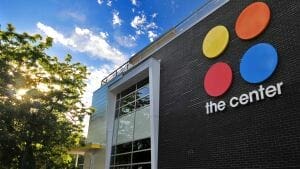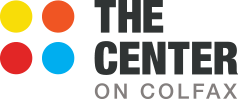History of The Center
Early Days in Denver

Phil Nash in The Center on Colfax's 1st Office in 1979
On an ordinary day in the fall of 1972, five people met in a Denver apartment to discuss one common interest – how to become more involved in the gay liberation movement. Little did this group know at the time, but within just a few short months their efforts would forever change gay life in Denver and create a foundation for The Center as we know it today.
Gerald Gerash, Lynn Tamlin, Terry Mangan, Jane Dundee and Mary Sassatelli set out to create a grassroots movement in Denver to expose the unjust treatment of gay men by police. At the time, gays were being singled out for arrest for simply dancing or kissing. The five colleagues formed the Gay Coalition of Denver (GCD).
“From the very beginning, GCD acted much like a community center. We had a hotline, counseling referrals and a speaker’s bureau. Our coffee house, Approaching Lavender, was a welcome alternative to the bars. Denver Free University donated its building where we offered weekend evenings of movies, guest speakers, women’s nights, poetry readings, live music and a variety of entertainment,” recalls Gerash.
In October 1973 the GCD took their fight for equality to the courts. A civil lawsuit, Gay Coalition of Denver vs. Denver, gave GCD access to police records, where they discovered some alarming statistics – 98% of those arrested for “offer of lewd conduct” were gay men.
With this information and a legion of 300 supporters, the GCD approached the Denver City Council. Thirty-five speakers gave three hours of testimony and as a result, four laws regarding loitering, cross-dressing, renting out rooms for "purposes of sexual deviant purpose" and polices that enabled police entrapment through solicitation were repealed. The court later ordered that police could not enforce criminal laws in a discriminatory manner against gays nor could they make arrests for kissing, hugging, dancing or holding hands.
"United We Stand, Divided We Fall"
These historic wins for gay liberation were a step in the right direction but they did little to solve the larger problems within the community. In the mid-1970s, the vast majority of Denver’s gays and lesbians were in the closet, fearful of the being exposed to their families, employers, neighbors and friends. Alcoholism, drug addiction, low self-esteem, and suicide were the ugly byproducts of gay shame. By the fall of 1975, Gerald Gerash noted that the community had achieved major victories; however, an institution was needed to serve the needs of the gay and lesbian community.
"I believed it was time to create our own institution to take care of our own and to empower the powerless" noted Gerash.
Gerash lead the formation of a group called Unity, an "organization for organizations" to create a community center. Ten groups heeded the call, met, and unanimously agreed to establish a community center. After the vote, they stood up and with arms around shoulders, sang a rousing, "United We Stand, Divided We Fall."
The effort was further coordinated by Unity's Interim Board of Directors. Five committees began a campaign of grass roots organizing, education, outreach, and fundraising. Unity grew from 10 to 39 groups, especially after Gay Pride Week 1976, reflecting the "coming out" and growth of the GLBT community in Denver. Over a weekend in September 1976, 22 members of Unity met to brainstorm a range of issues and hammered out the purposes and by-laws of a Center. Two months later the Gay Community Center of Colorado (GCCC) (Lesbian, Bisexual and Transgender were added later), was incorporated.
After two years of passionate dedication, about ten thousand dollars raised, thousands of volunteer hours, and fighting for a staff and office space, The Center opened in August 1977.
The Center's Beginnings
Phil Nash, one of the GCC’s first volunteers and first salaried coordinator, talks about The Center’s beginnings:
“From day one, The Center’s main service was helping people come out. They called. They dropped in – often after walking by the building a dozen times to build up the courage. They read books in the library. They volunteered. They started new activities. The Center ran 12 hours a day, six days a week on ‘coming out energy.’ Donors arrived with cash in hand, fearing to write “gay” on a check. In the early days, it was mostly men, but The Center started the Everywoman’s Coming Out Group with weekly meetings that overflowed the largest meeting room for years.”
Over the next three decades the GCC would see many changes. As the organization grew to be more inclusive, the name was changed to the Gay, Lesbian, Bisexual and Transgender Community Center of Colorado, or more simply - The Center. The 1980s brought with it the first wave of the HIV/AIDS epidemic, and The Center responded by launching an effort that later became the Colorado AIDS Project. During this same decade, a bold new program aimed at LGBT youth was formed, which included several youth support groups, a foster care program, and youth leadership opportunities. This program laid the foundation for Rainbow Alley.
The 1980s also saw greater visibility for gay and lesbian organizations and a wider recognition of the LGBT community as a political force. Federico Peña, Denver’s first Hispanic mayor, was elected in 1983. Peña made efforts not only to reach out to, but also to include the LGBT community in his vision of Denver as a “Great City”.
“There was discrimination in the 80s, especially if you were an educator, where the lack of anti-discrimination laws made it impossible to be out; but Denver had yet to become oppressed enough to be a hub for political activity,” says Shari Wilkins, lifelong resident and former manager of The Center’s SAGE of the Rockies program.
“There was vibrant social scene in the city, with seven lesbian bars, including the Velvet Hammer, Three Sisters, and Miss C’s, and even more bars for gay men,” says Wilkins.
Marching Forward

Carol Lease (right)
In 1985, the Mile High Freedom Band, Denver’s first gay and lesbian community band, made its debut in the St. Patrick’s Day Parade, drawing much media attention for the LGBT community. Just one year prior, Carol Lease, then Director of The Center, had been denied permission for a group from The Center to march in the same parade.
“This was a key time in Denver,” says Lease. “The Center published the Colorado Gay and Lesbian News, provided outreach services for young gay men who traded sex for money at Sodomy Circle (the driveway around the State Capitol), worked with Mayor Peña to stop Denver police from issuing jaywalking tickets to gay bar patrons, institutionalized DATACALL as a discrimination hotline and advocacy project, and continued to educate the community at large about the ongoing discrimination.”
During the 1990s, The Center’s community-building efforts suffered losses in financial resources and leadership as Colorado’s LGBT community and allies were forced to organize against a series of anti-gay political initiatives. Amendment 2, passed by voters in 1992, went so far as to rescind rights that were already part of local and state law. The Colorado Legal Initiatives Project (CLIP), which was the foundation for today’s Legal & Advocacy Program, formed to raise funds and challenge Amendment 2 at the U.S. Supreme Court. The Justices overturned it 6-3 on May 20, 1996.
Rebuild and Rebirth
After this victory, The Center began to rebuild with substantial support from the newly formed Gill Foundation. The Center began an anti-violence campaign in the early 1990s that later branched off on its own, becoming the Colorado Anti-Violence Project. Lavender University, The Center’s community education program, offered free classes on a wide variety of topics to anyone in the community, gay or straight. Youth programming was increased through the formalization of Rainbow Alley in 1998.
The 1990s also saw major changes to the Denver PrideFest celebration.
“There had previously been a smaller pride celebration organized by the courts; but after 1989, the Center took over running it and transformed it into of what we see today – starting initially with about 10,000 people attending and growing each year,” says Sue Anderson, Executive Director of The Center from 1988-92.

The Center on Colfax now (2013)
As the baby boom generation found itself approaching retirement, the need for more programs aimed at LGBT elders became apparent, and SAGE of the Rockies was formed in 2009 to fill the gap. New programs for the transgender community were also established in the 2000s and PrideFest became a two-day festival drawing nearly 300,000 attendees to Denver’s Civic Center Park by the decade’s close. This tremendous growth brought about the need for more space. On July 6, 2010, after a two-year journey through fundraising and construction, The Center moved into its new 15,000 square foot home in Capitol Hill, just one-half block from its very first office.
Nearly four decades ago, five like-minded individuals dared to dream of a better way to live. That dream has evolved into one of the oldest and largest LGBT centers in the U.S.
“The Center represents the gift of one generation to the next. Its history is a measure of our progression from indignant obscurity to full-fledged maturity as an anchor institution in the community. Where do we go from here? A few of us can write our history. But it takes all of us to write our future,” says Phil Nash.
